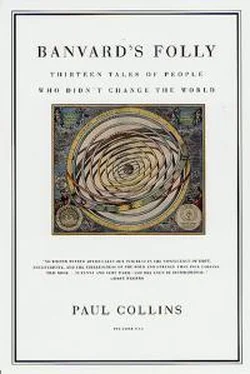chapbook of Dick's The Solar System. It was published in America by the American Sunday-School Union, one of a countless number of tract societies that flooded the American frontier and the British countryside with edifying books on science, theology, and treacly moral tales. Dick's name doesn't appear anywhere on it. Nor does it have any hint of Dick's far-out cosmology: to look at it, you'd think it was nothing more than a nice little guide to the planets put out by a nice little church press. We can only imagine some grizzled dirt farmer in Nebraska scratching his beard as he set his copy down, pondering the building of a Siberian monument to communicate with Lunarians.
Amusingly enough--though not for Thomas Dick, had he lived to see it--Locke's hoax stayed in print longer than the work it spoofed. Dick went out of print not long after his death in 1857, while Locke's Great Astronomical Discoveries outlasted Locke himself with a fifth edition in 1871, the same year that he died.
So why did Dick's works go out of print first? For one thing, Dick's narrative became almost less credible than Locke's. Presented with evidence that didn't accord with his notion of a wise and kindly God, Dick would reject it out of hand. For example, an apparent glow on the moon had been attributed by some colleagues to lunar volcanoes. Impossible, Dick declared: volcanoes were the result of our fall from grace, and the presence of "such appalling and destructive agents ... would be to virtually admit that the inhabitants of that planet are in the same depraved condition as the inhabitants of this world." He reacted the same way to correct evidence of screamingly high wind speeds on Jupiter. Such observations, he sniffed, simply showed our ignorance of the planet's indubitably pleasant weather: "A West India hurricane, blowing at the rate of a hundred miles an hour, has blown heavy cannon out of a battery. ... What, then, would be the force of a gale moving at the rate of a thousand miles per hour? [It is] altogether inconsistent with the idea of a comfortable habitation either for sensitive or intellectual beings."
Natural theology's ensuing death was slow and painful. Its vulnerability lay in its ultimate allegiance to scripture, rather than to scientific methodology. When scripture didn't accord with scientific fact, the resulting reinterpretation of scripture took it farther and farther away from a literal reading of the Bible, and farther out of the grasp of popular understanding.
After 1850, in the first glimmerings of evolutionary biology and quantum physics, the link became so tenuous that one may as well be speaking of two
different subjects entirely: nature, and theology. Most people did, and so came the end of natural theology.
The only other easy option, an admission that scripture might be wrong, was dismissed out of hand by theorists like Whewell: "The results of true geology and astronomy cannot be inconsistent with the statement of true theology."
Whewell himself declined in his later years into ineffectual and pathetic attempts to have copies of Darwin removed from his college library.
Dick was spared from these sights; when he died in 1857, the first drops of Darwinism had not yet eroded public belief. Posterity has been less kind to him, though: his once-popular tracts are difficult to find, and have been entirely out of print for well over a century. The 1855 edition of his complete works that I found at UCLA still had uncut pages.
As far as I could tell, I was the first person in 143 years to even open it.
FURTHER READINGS
JOHN BANVARD
The greatest keeper of the Banvard flame was John Francis McDermott, and his 1958 book, The Lost Panoramas of the Mississippi, though long out of print, is well worth finding. Not only is it thoroughly illustrated and researched, it also discusses the minor industry of imitators that sprung up around Banvard's innovations.
Any modern account of John Banvard is indebted to the pioneering scholarship of John Hanners. He wrote his 1979 Michigan State University dissertation on Banvard--"The Adventures of an Artist." Sections of it are reworked and wedged into his book It Was Play or Starve (bowling Green State University Popular Press, 1993); a shorter, illustrated version turns up in his article "John Banvard and His Floating Theatres," Traces of Indiana and Midwestern History, Vol. 2, No. 2, (spring 1990).
Two of the few scholarly efforts to precede those of McDermott and Hanners are Joseph Arrington's "John Banvard's Moving Panorama of the Mississippi, Missouri, and Ohio Rivers," Filson Club History Quarterly, July 1958; and Doane Robinson's "John Banvard," South Dakota Historical Society, Vol. 21
(1942). A broader and more recent account is also given in Ried Holien's "John Banvard's Brush with Success," South Dakota Magazine, September/october 1997.
The New York Public Library has two interesting sidelights on Banvard's life:
"The Holy Land," an article on his Middle Eastern travels, in Gleason's Pictorial Drawing Room Companion, 1854, pp. 388-89); and an account of the building of the ill-fated Glenada castle, "Banvard, the Artist, and His Residence," in Ballou's Pictorial Drawing Room Companion, 1857, p. 312. But the best insight into Banvard's life comes from his own (and sometimes unreliable) accounts in the Banvard Family Papers (minnesota Historical Society, St. Paul, Minn.). Other archives include the Banvard file at the Watertown Regional Library, Watertown South Dakota, and the Banvard Collection at the South Dakota Historical Society, in Pierre, South Dakota.
As for Banvard's own publications, the New York Public Library houses Banvard's System of Short-Hand (1880) and The Origin of the Building of Solomon's Temple (1886). Banvard's seminal accounts Banvard's Panorama of the Mississippi River (boston, 1847) and Banvard, or the Adventures of an Artist (london, 1851) are rarities indeed, though some larger university libraries have them on microfilm. The New-York Historical Society has an original printed copy of the latter.
Banvard's masterpiece remains vanished, of course. But what of his competitors? Most of their work seems to have met a similar fate, with one notable exception. A 1200-foot moving panorama based on Bunyan's Pilgrim's Progress was executed in 1850 by some of New York's top painters (including Frederic Church) and traveled around the country. Amazingly, it turned up whole in 1995 at the York Institute Museum in Saco, Maine, where it had been utterly forgotten in a storage area for nearly a century. It has been restored and shown to the public; Holland Cotter's account of the exhibition, "A Pilgrim's Perils in an Ancestor of B-Movies," with some dramatic color illustrations, appeared in the Sunday, April 4, 1999, issue of the New York Times.
WILLIAM HENRY IRELAND
There is a wealth of material out there, thanks in large part to a series of facsimile reprints made in the late 1960's and early 1970's of most of the primary sources involved in the Shakespeare forgery scandal. The 1799 combined edition of Vortigern and Henry the Second (1799) is easy to find in major research libraries and used book searches, as is Ireland's fascinating Confessions of William Henry Ireland (1805). A variety of attacks and counterattacks from the time, including Edmond Malone's An Inquiry Into the Authenticity of Certain Miscellaneous Papers ... (1796were, Samuel Ireland's An Investigation of Mr. Malone's Claim to the Character of Scolar, or Critic (1798), and George Chalmers's An Apology for the Believers in the Shakespeare-Papers (1797), are all also widely available. Some of the original forgeries may also be found at the British Library.
The most readable recounting of the Ireland tale is John Mair's The Fourth Forger (1938), although Bernard Grebanier's more detailed The Great Shakespeare Forgery (1965) is also quite good. Jeffrey Kahan's monograph Reforging Shakespeare (1998) has a strong whiff of dissertation about it, and he grinds his ax down to a little nub; he's absolutely determined to prove that Ireland was a malicious criminal mastermind. Still, it's the best-researched of all the accounts of Ireland, and a useful corrective to the many lapses in credulity by earlier writers.
Читать дальше











